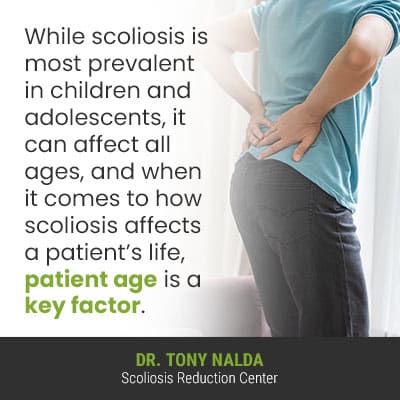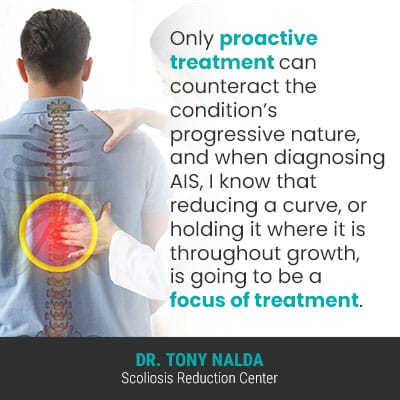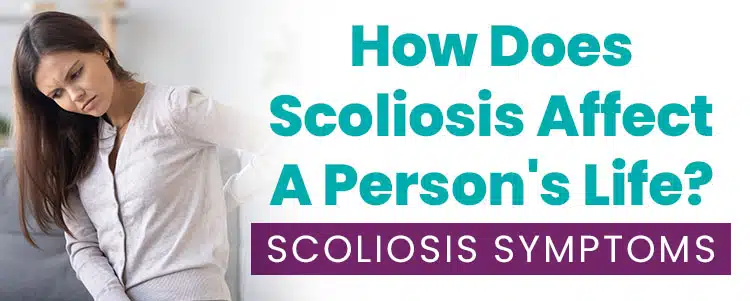The complex nature of scoliosis necessitates the customization of effective treatment plans based on patient age, curvature location, condition type (cause), and severity. Treatment plans are always different because each case is as unique as the patient themselves. Continue reading to find out how the condition’s classification points shape how scoliosis can affect a person’s life.
Scoliosis doesn’t just range widely in severity; there are also different condition types a person can develop, each with its own unique causation and treatment needs. Scoliosis symptoms will vary from person to person based on key patient/condition variables.
Before discussing how scoliosis is classified, and the important factors that shape the types of symptoms one can expect, let’s start with the condition’s general effects on the body.
How Does Scoliosis Affect You?
For those recently diagnosed with scoliosis, it’s natural to wonder exactly what the diagnosis means, and how it will affect life in general.
Being diagnosed with scoliosis means an unnatural sideways spinal curve, with rotation, making it a 3-dimensional condition, and a minimum Cobb angle measurement of 10 degrees, has developed.
It’s important to understand that healthy spines also have curves, but they are natural and healthy; when viewed from the side, a healthy spine will take on a soft ‘S’ shape, and when viewed from the front and/or back, it will appear straight.
The spine’s natural and healthy curves make it stronger, more flexible, and better able to absorb/distribute stress incurred during movement, so when the spine loses one or more of its healthy curves, it can affect the body in a number of ways.
Remember, the brain and spine work in tandem to form the body’s central nervous system, so spinal conditions can cause a wide range of symptoms felt throughout the body.
So being diagnosed with scoliosis means the body is being exposed to a lot of uneven forces, and in terms of scoliosis symptoms, postural deviation and pain are the most prevalent.
It’s also important to understand that as a progressive condition, where a scoliosis is at the time of diagnosis is not indicative of where it will stay; scoliosis that’s mild at the time of diagnosis can easily progress to moderate, severe, or very severe, particularly if left untreated, or not treated proactively.
Now that we’ve discussed what a scoliosis diagnosis means, let’s move on to addressing the condition’s classification points, and how each one can shape the types of symptoms a patient is likely to experience.
How Scoliosis is Classified
When scoliosis is diagnosed, part of the process involves comprehensively assessing conditions based on key patient/condition variables: patient age, condition type (cause), curvature location, and condition severity.
No two cases of scoliosis are the same, which is why a scoliosis specialist is needed to treat the condition effectively: a treatment provider who is trained and experienced in addressing the specifics of such a highly-variable and complex progressive condition.

While scoliosis is most prevalent in children and adolescents, it can affect all ages, and when it comes to how scoliosis affects a patient’s life, patient age is a key factor.
Patient Age
Patient age is not just an important indicator in terms of general health and physical fitness, but also because patient age contributes to whether or not the condition is compressive and likely to be painful.
The main cause of condition-related pain is compression: compression of the spine and its surrounding muscles and nerves.
When it comes to people asking, how does scoliosis affect your life, pain is an important factor, as is how bad a condition can get, and patient age also indicates likely progressive rates.
Adult Scoliosis Symptoms
For children and adolescents, scoliosis isn’t commonly described as painful, but for adults, pain is the number-one symptom, and this is related to growth; in younger patients who are still growing, their spines are experiencing a constant lengthening motion, and this counteracts the compressive force of the unnatural spinal curve.
So while adolescents do report experiencing various levels of muscle pain, in terms of localized back pain, and radicular pain caused by compression, patient age is a big indicator as to whether or not a patient’s treatment plan is going to have to focus on pain management.
So for adults with scoliosis, back and/or radicular pain is likely going to be a part of life, and this can range from mild and intermittent to chronic and debilitating; in fact, radicular pain felt in the hands and feet is one of the most common symptoms of adult scoliosis.
Now, when it comes to progression, growth is the condition’s main progressive trigger, so for adults who are no longer growing, counteracting progression is not likely going to have to be a focus of treatment; we have more time to work towards a curvature reduction, pain management, and stabilizing the spine.
Adolescent Idiopathic Scoliosis Symptoms
Now, in the condition’s most-prevalent form, adolescent idiopathic scoliosis (AIS), diagnosed between the ages of 10 and 18, postural deviation is likely to be the most noticeable symptom.
Due to the condition’s introduction of uneven forces to the body, its overall symmetry can be disrupted, and in cases of adolescent idiopathic scoliosis, the condition’s earliest signs are changes to posture.
While other factors such as condition severity and the degree of rotation factor into whether or not postural changes are subtle or overt, following are some common visual symptoms associated with AIS:
- Uneven shoulders with one sitting higher than the other
- Uneven shoulder blades with one protruding more on one side than the other
- The development of a rib arch
- An uneven waistline
- Uneven hips
- Arms and legs that appear to hang at different lengths
In addition to the aforementioned symptoms, clothing can become ill-fitting, and changes to gait, balance, and coordination can be additional symptoms.
So with my adolescent patients, typically, pain management isn’t a necessary focus of treatment, but progression, however, is.
As growth and development is the condition’s main trigger for progression, young patients are at risk for rapid-phase progression, especially adolescents in, or entering into, the stage of puberty, characterized by rapid and unpredictable growth spurts.

Only proactive treatment can counteract the condition’s progressive nature, and when diagnosing AIS, I know that reducing a curve, or holding it where it is throughout growth, is going to be a focus of treatment.
Now that I’ve explained how patient age can shape condition symptoms and progression, let’s move on to the next classification point: condition type.
Condition Type
As mentioned, AIS is the condition’s most-prevalent form, but there are multiple different types of scoliosis a person can develop.
The idiopathic designation in adolescent idiopathic scoliosis means not clearly associated with a single-known causative source; we don’t fully understand its etiology.
Idiopathic scoliosis is also the most common type to affect adults, and idiopathic scoliosis accounts for approximately 80 percent of known diagnosed scoliosis cases.
The remaining 20 percent are associated with known causes: neuromuscular scoliosis, congenital scoliosis, degenerative scoliosis, and traumatic scoliosis.
In order to treat scoliosis effectively, its underlying cause has to be addressed, not just the condition’s symptoms, and symptoms will also be shaped by condition type.
For example, when it comes to neuromuscular scoliosis (NMS), the scoliosis has developed due to the presence of a larger neuromuscular condition such as muscular dystrophy, cerebral palsy, and spina bifida, to name a few, and it’s the underlying neuromuscular condition that has to be the focus of treatment.
Curvature Location
There are three main spinal sections: cervical (neck), thoracic (middle/upper back), and lumbar (lower back).
The thoracic section contains the most vertebrae (bones of the spine) and is the most commonly affected by scoliosis, but it can develop in any of the spine’s main sections.
In most cases, the area of the body most likely to be affected by scoliosis is the area closest to the spinal section with the unnatural spinal curve.
For example, in cases of lumbar scoliosis, its effects are mainly felt throughout the lower body, and while it’s not guaranteed, a common complication of lumbar scoliosis is sciatica.
The sciatic nerve originates in the lower back, so when scoliosis in the lower back compresses nearby nerves, it can cause the development of sciatica (pain felt anywhere along the sciatic nerve’s pathway, which is extensive).
So curvature location can also factor into how scoliosis affects the back and/or the rest of the body.
Let’s move onto condition severity, based on a measurement known as the gold standard in the assessment of scoliosis, and the more severe a condition, the more likely its symptoms are to be overt.
Condition Severity
Condition severity is determined based on a patient’s Cobb angle, and this is a measurement taken during X-ray that involves drawing intersecting lines from the tops and bottoms of the most-tilted vertebrae of a scoliotic curve, at its apex, and the intersecting angle is expressed in degrees.
As a scoliotic curve develops, the spine’s unnatural curve is forcing it out of alignment, and this disrupts the spine’s overall health, function, and biomechanics.
The higher the Cobb angle, the more noticeable its symptoms are likely to be, and the more severe the condition:
Mild scoliosis: Cobb angle measurement of between 10 and 25 degrees
Moderate scoliosis: Cobb angle measurement of between 25 and 40 degrees
Severe scoliosis: Cobb angle measurement of 40+ degrees
Very-severe scoliosis: Cobb angle measurement of 80+ degrees
Symptoms are shaped by severity because the larger the unnatural spinal curve, the more out of alignment it is, the more uneven forces are being introduced to the body, the more potential for compression (in adults), and the more noticeably it’s going to disrupt posture.
So the answer to, how does scoliosis affect daily life, will be case-specific based on key patient/condition factors.
Conclusion
The way scoliosis affects a person’s life will depend on a number of variables that vary from patient to patient, and also how that patient decides to treat their scoliosis moving forward.
There are two main scoliosis treatment approaches for patients to choose between, traditional and conservative, and how each responds to a diagnosis shapes potential treatment efficacy, and patient-experience.
Traditional treatment chooses a more reactive response, while conservative treatment values being proactive.
For those choosing a conservative approach, treatment is started as close to the time of diagnosis as possible, and this is in the hopes of preventing progression, increasing condition severity, escalating symptoms, and the need for invasive surgical treatment in the future.
In most cases of adult scoliosis, the main symptom is pain, both localized back pain and radicular pain felt throughout the body, and the most common way in which scoliosis affects the daily lives of adolescents is in the visual symptoms it causes: changes to posture and gait.
So while scoliosis has the potential to affect the body in a myriad of ways, its effects can be minimized through proactive treatment offered here at the Scoliosis Reduction Center®.




